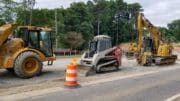Image above created with DALL-E from ChatGPT
By Larry Felton Johnson
Here is a quick summary of the article below:
- The Cobb County Northwest Water Reclamation Facility reported spills of disinfected wastewater into Lake Allatoona on June 26, June 30, July 1, and July 2.
- The county announced the spills and stated there was no danger to the drinking water.
- The county told the Courier that the reading that caused the “spill” designation was for Total Suspended Solids (TSS)
- In a written report, the Northwest WRF described the cause of the rise in TSS as a bacterial outbreak that “resulted in poor settleability of solids in the facility”
- As a corrective, the facility “placed all Primary Clarifiers and Secondary Clarifiers into service. This included 3 Primary Clarifiers, 4 Aeration Basins and 3 Secondary Clarifiers.”
- Eventually, this brought the TSS back to a normal range, but testing continues.
- The facility then tested for E. Coli in Lake Allatoona, and “no high levels were observed.”
- The Courier sent a series of questions to Dr. Daniel Ferreira, an environmental scientist on the Kennesaw State University faculty, asking him to explain Total Suspended Solids and their possible effect on Lake Allatoona.
On four dates (June 26, June 30, July 1, July 2), Cobb County’s Northwest Water Reclamation Facility reported test readings in the disinfected wastewater the facility released into Lake Allatoona that didn’t meet the standards of the Georgia Environmental Protection Division. When that happens, the release is classified as a spill, even if there is no immediate risk to the public.
Under the guidelines, the facility was required to contact the EPD to report the spills. The first contact is by phone, and the facility later files a written report once more information is gathered and corrective steps are in place.
Cobb County also had to release a public notice that the spill had occurred, which it did on all four occasions.
The county wrote in its news release about the spills that the wastewater was disinfected and posed no risk to the drinking water supply.
In response to an inquiry from the Courier, Cobb Communications Director Ross Cavitt wrote in an email that the call was placed from the facility to the EPD because of an out-of-range reading for Total Suspended Solids.
The facility’s written report submitted to the EPD stated that the cause of the rise in TSS was a “filamentous bacteria colony outbreak and a reduction in active microorganisms in the aeration system.” Follow this link to read the complete report.
“The presence of filamentous bacteria and a prevalence of colloidal solids resulted in poor settleability of solids in the facility.” the report continued. “These conditions resulted in the degradation of the effluent quality and result in a discharge that did not meet the quality established by the NPDES Permit for total suspended solids and carbonaceous biochemical oxygen demand.”
The report then stated, “Although the events were caused by a single plant upset lasting several days, each day that we received lab results that were classified as a spill, we reported a spill each day.”
In the report, the facility described the corrective actions it took to control the bacterial outbreak and bring the TSS levels to an acceptable range, including placing “all Primary Clarifiers and Secondary Clarifiers into service. This included 3 Primary Clarifiers, 4 Aeration Basins and 3 Secondary Clarifiers.”
The actions eventually brought the TSS to normal levels, but the facility continues to monitor. Testing for E. Coli in Lake Allatoona was also done, and no elevated readings were reported.
What does all this mean?
The Courier contacted Dr. Daniel Ferreira, an environmental scientist on the Kennesaw State University faculty, asking him to explain Total Suspended Solids and their possible effect on Lake Allatoona.
1) The county emphasizes that the TSS readings won’t affect the drinking water but they didn’t address the effects of water quality on a recreational lake. What is the danger of repeated spills of TSS on a large lake beyond dangers to the drinking water?
So, a little background first… TSS is kind of an unusual parameter because it tells you that there are solids suspended in the wastewater stream, but it doesn’t tell you what those solids are. Keep in mind that wastewater treatment plants treat wastewater discharged into the sewer system but they also treat stormwater runoff.
So, in addition to the human waste entering the plant, they also have to deal with anything that washes into a stormwater drain. This can include things like soil, trash, and any pollutants that are on paved surfaces (like the pollutants that come out of cars’ tailpipes and get deposited on the roads for example).
Wastewater treatment plants are mainly designed to get rid of the nutrients in our waste (nitrogen and phosphorus mostly) as well as the carbon. Sometimes other things suspended in the wastewater make it through the treatment process. Things like small particles of clay or silt from soil erosion can stay suspended in the water column and can be unaffected by the wastewater treatment process. These solids will then get discharged into the surface water body that the wastewater treatment plant uses for its effluent.
Now these solids are not necessarily dangerous. The main impact they will have is to make the water column cloudy, which decreases the amount of sunlight penetrating the water body.
This can be harmful to photosynthetic organisms that live in the water body because now they aren’t getting as much sunlight to photosynthesize with.
If this is a short-lived effect, it’s no big deal. The photosynthesizers have a few bad days, but when the solids settle out and the water becomes clear again, they will bounce back. If it’s a sustained issue though, that can become a bit more problematic. Those small photosynthetic organisms form the base of the food chain in many aquatic ecosystems.
So, if they go a long period of time without being able to photosynthesize and this impacts their population, the filter feeders that eat them will begin to suffer too because now they don’t have as much food to eat. Then the organisms that eat the filter feeders begin to suffer, and so on and so forth up the food chain. In the really long-term you’re risking the collapse of the ecosystem, but that would have to be a really serious quantity of TSS being discharged for a very long time before that would be a realistic concern.
For a recreational water body that supports fishing, this may lead to population decreases in fish species that people are trying to catch, and that might leave some local residents disgruntled.
If the water body supports swimming, people might not be too keen on going swimming in water that’s brown because of too much suspended material.
They might get even more upset if they go in the water and come out with a film of sediment covering their bodies. Granted, a quick shower will solve this problem, but as a citizen paying taxes to support that park, I might not feel like I’m getting my money’s worth as a contributing citizen and would probably want to know that something is being done to keep this from happening regularly.
2) What failure points might result in out-of-range TSS readings? Where in the equipment workflow is TSS filtered?
Wastewater treatment plants typically have a primary and a secondary clarifier. These are large settling tanks where solids suspended in the wastewater are supposed to settle out. Depending on the plant they may also have a bed of anthracite to filter that wastewater stream. I can’t remember if the north Cobb facility has that kind of setup. I know the large wastewater treatment plant down in Smyrna does.
But that kind of filtration is expensive, and doesn’t completely eliminate this problem either. Allowing solids to settle out of the water column is much cheaper and usually works just fine. The problem, I would imagine, is when the wastewater contains a larger than normal amount of very fine suspended solids.
As I’m sure you know, GA soil has a lot of clay in it. And clay particles are super tiny… smaller than 2 microns in diameter. To put that in context, a human hair is about 50 microns in diameter.
If there’s a big rain event and a lot of clay washes into the storm drains in the area, that’s going to be a really big problem. These particles are so small, they’re not likely to settle out in the clarifiers and even the anthracite filters might not catch all of them. We have had some pretty nasty thunderstorms in the last couple of weeks.
I’m not sure how the weather matches up with the dates of those releases, but I wouldn’t be surprised if it turns out there was a really intense thunderstorm just before they happened. And if there was a lot of clay in the wastewater inflow, the wastewater treatment plant might not be able to handle that and it might then wind up in the effluent being discharged into surface water.
3) Does the reclamation facility do a further breakdown on the composition of the TSS? The things I’ve read state it can be anything from sand and silt to algae and bacteria?
Based on the monitoring document you sent me, it doesn’t look like they have that kind of data. I don’t think it’s part of routine testing. The test for TSS just tells you how much solid material is suspended, it doesn’t tell you what those materials are. They literally just take a sample of the effluent, evaporate the water off, then weigh the solids left over in the container.
Report from the Northwest Water Reclamation Facility to the Georgia EPD concerning the spills
Here is the report submitted to the Georgia Environmental Protection Division of the Georgia Department of Natural Resources:
COBB COUNTY WATER SYSTEM
Water Protection Division
Northwest Water Reclamation Facility
NPDES Permit Number GA0046761
Noncompliance / Spill Report
June 26, June 30, July 1, July 2, 2024
Description and Cause
Northwest Water Reclamation Facility experienced noncompliance and spills for total suspended solids and carbonaceous biochemical oxygen demand as listed in the table below.
| DATE | TSS mg/L | CBOD mg/L | Eff Flow MGD |
| 6/26/2024 | 38.4 | 13.6 | 3.85 |
| 6/30/2024 | 125 | 21.4 | 7.25 |
| 7/1/2024 | 154 | 25.7 | 5.68 |
| 7/2/2024 | 327 | >38.7 | 6.74 |
Northwest WRF experienced a sever filamentous bacteria colony outbreak, and a reduction in active microorganisms in the aeration system. Microscopic analysis identified evidence of toxicity in aeration basin samples. Those samples have been sent to an outside contracted lab, and those results are pending.
The presence of filamentous bacteria and a prevalence of colloidal solids resulted in poor settleability of solids in the facility. These conditions resulted in the degradation of the effluent quality and result in a discharge that did not meet the quality established by the NPDES Permit for total suspended solids and carbonaceous biochemical oxygen demand.
Due to poor settling and the reduction in active microorganisms in the aeration basins, effluent quality degraded resulting in high levels that were classified as a spill for each day that they occurred. Although the events were caused by a single plant upset lasting several days, each day that we received lab results that were classified as a spill, we reported a spill each day. The results are in the table below.
These exceedances will result in monthly and weekly permit non-compliance as well, and will also include nitrogen ammonia exceedances. A full report covering those data will be submitted once all results are received, calculated, and reported in NetDMR for the month of June 2024.
Corrective Action
The facility placed all Primary Clarifiers and Secondary Clarifiers into service. This included 3 Primary Clarifiers, 4 Aeration Basins and 3 Secondary Clarifiers. Microscopic observations during this time revealed very low protozoa organism populations, indicating very low beneficial heterotrophic and autotrophic bacterial populations needed for treatment. A sample from the aeration basin was collected and sent to outside lab. Several species of Filamentous Bacteria were identified with the predominate species being Type 021N and S. Natans which were both rated a 6 in abundance on a scale of 0 to 6. Filamentous Bacteria Type 0675/0041 was rated a 3 in abundance. The report also stated that there were very few higher life forms. Specifically, the sample that was analyzed lacked Amoeboids, Flagellates, Swimming and Crawling Ciliates and/or Rotifers.
The activated sludge wasting (WAS) rate was increased to 0.2 MGD in order to lower sludge age and help control the filamentous bacteria. The facility began adding High Test Hypochlorite (HTH) pucks to the Aeration Basin influent channel to chlorinate the system in order to control the Filamentous Bacteria. As a result of microscopic evaluation performed onsite and by an outside lab, the plant was ‘seeded’ on several occasions from other Cobb County Water System Water Reclamation Facilities in order to re-establish the biological treatment process. Each seed load was 5,000 gallons. In addition to seeding from other facilities, Northwest WRF also added KPAK 1000 Nitrifiers, which is a bioaugmentation product containing nitrifying bacteria. Chemical feed adjustments were made to ensure a suitable environment for the nitrifying bacteria and for nitrification to occur. The Poly-Aluminum Chloride (PAC) dosing rate, which is used as a settling agent, was increased to improve settling in the Secondary Clarifiers.
On Wednesday, June 26, 2024, solids began to leave the Secondary Clarifiers and blind the Automatic Backwash Filters, resulting in a limitation on flow that they could process. Flow was reduced to prevent overflows at the automatic backwash filters.
However, on Friday, June 28, 2024, solids leaving the Secondary Clarifiers again began to further blind the Automatic Backwash Filters. The facility had previously reduced the flow through the plant to reduce the solids loading on the filters. This resulted in all 4 EQ’s Tank reaching maximum capacity. The last 4 Aeration Basins were placed into service. The bypass to the Automatic Backwash Filters was opened to reduce the loading on the filters, in order to allow the facility to treat the flow it was receiving. Adjustments were made to send the maximum amount through the filters. The Poly-Aluminum Chloride (PAC) dosing rate was increased to improve settling in the Secondary Clarifiers Two Ultraviolet Disinfection units were placed into “Hand” and operated at 100 percent intensity. The Sodium Hypochlorite feed was also increased to assist the UV Disinfection and ensure disinfection occurred. Free Chlorine test were also performed. The facility increase flow into the facility from the equalization tanks.
On July 3, 2024, the representative from our polymer vendor was onsite and performed jar testing to assist in the determination of dosing needed to promote solids settling in the Secondary Clarifiers. This was completed at approximately 10:00pm. Once polymer feed to the secondary clarifiers was achieved, the colloidal solids began to settle properly, and the solids levels in the plant effluent returned to normal levels.
Also of concern were bacteria levels in Lake Allatoona near the Northwest WRF effluent discharge. Spill sampling results for E. Coli are listed below. E. Coli levels above and below the effluent discharge were a baseline levels for the lake; no high levels were observed. Spill sampling continues to be performed.
| DATE | E. Coli MPN/ 100 mL Above Eff Discharge | E. Coli MPN/ 100 mL Below Eff Discharge |
| 6/26/2024 | 5 | 21 |
| 6/30/2024 | 1 | 3 |
| 7/1/2024 | 16 | 2 |
| 7/2/2024 | 8 | 1 |
About the Northwest Water Reclamation Facility
The Cobb County Water System’s Northwest Water Reclamation Facility is located at 3740 Highway 293 in Kennesaw, in the northwest corner of the county near Proctor Creek.
It treats from the northwest quadrant of unincorporated Cobb County; the cities of Acworth and Kennesaw; and portions of Bartow, Cherokee, and Paulding counties.
According to the Cobb County Water System web page for the Northwest Water Reclamation Facility:
The facility reclaims wastewater, producing reuse-quality water that is either discharged to Lake Allatoona through an underwater diffuser or provided to several urban reuse customers for irrigation purposes.
Originally built in 1987, the plant was sized to treat 2 million gallons per day (mgd), then upsized to 4 mgd in 1988. In 1997, the plant capacity was doubled, to a capacity of 8 mgd. The facility was again expanded in 2008, with an expanded capacity of 12 mgd.




